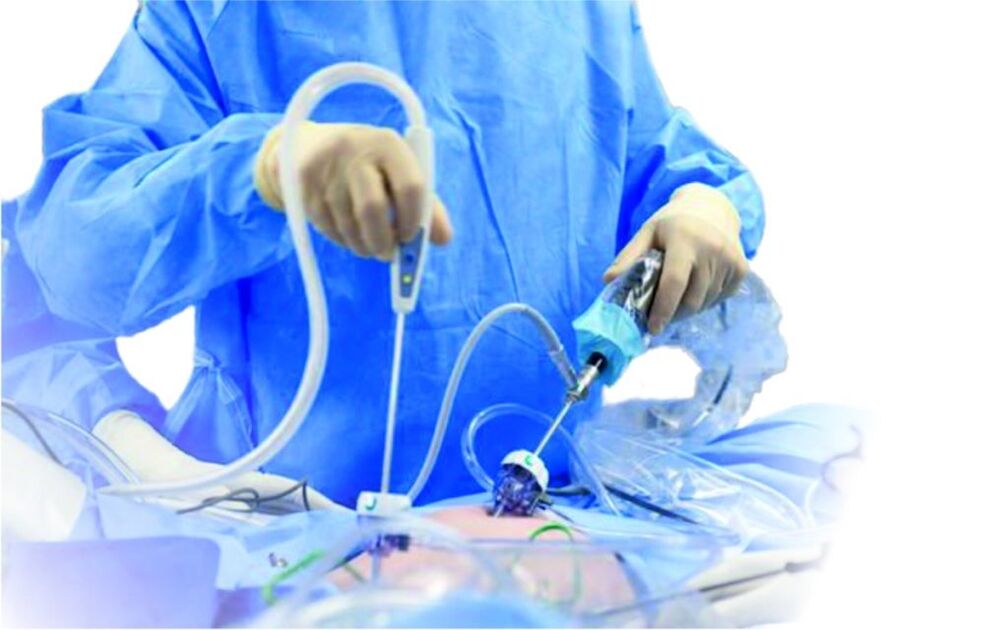Prostatitis is an inflammation of the male prostate gland located under the bladder and is a secondary part of the genitalia.
Every 7 people over the age of 35 suffer from prostatitis, and with every naked risk to develop the inflammatory process in increasing prostate under the influence of external and internal factors.
Cause

Inflammation of the prostate glands can develop for a variety of reasons, doctors distinguish their main:
- Violation of blood circulation in the pelvic organs - this leads to unstable processes and helps improve the prostate gland. The unstable process is facilitated by obesity and inactive lifestyle behavior.
- Explanation of bacteria, viruses or protozoa in the tissue against the background of acute or chronic inflammation in other organs flowing in the body - diseases such as angina, gonorrhea, urethritis, cystitis, flu, pyelonephritis can cause prostatitis. The agent that causes the infection can enter the prostate with blood and lymph flow if there is an infection in remote areas and organs.
- Injuries and bruises of abdominal soft tissue, perineum and external genitals - this leads to edema and impaired blood circulation in the damage zone;
- Hypothermia of the body.
- Chronic constipation.
- Hormone disorders.
- Storms or, on the other hand, are non -dangerous sexual life, both frequent sex (more than 1 day a day), as well as rare intimate relationships (less frequently 1 time a week), as this leads to a lack of sex glands or stagnation in the prostate.
Symptoms of prostatitis
Differentiate between forms of acute and chronic diseases.
Acute prostatitis is characterized by a sudden onset of the background of the general well -being, which is clinically accompanied by the following symptoms:
- chills and weakness;
- general malaise;
- increased irritation and anxiety;
- increase body temperature (not higher than 37. 5 degrees);
- attract or cut pain in the lower abdomen and perineum;
- Frequent impetus for urinating while maintaining an incomplete feeling of emptying on the bladder;
- The pain and difficulty of the river with bowel movement.
In the absence of timely diagnosis and treatment, acute prostatitis can be complicated by the purulent process and the release of pus from the urethra during urine.
Signs -Chronic prostatitis
In the transition of the disease into a chronic form of the course, clinical signs of prostatitis dim and patients appear to be recovery. Features -Features -Chronic inflammation process in the prostate gland burns along the urethra with irradiation to the throat, which can be enhanced during urination and drainage. Gradually, the disease lasts and causes impotence. Chronic prostatitis implies the period of forgiveness and severity, but even at the time of severity, the symptoms will be eradicated, not as expressed in the form of acute. The following symptoms appear clinically:
- difficulty with erection;
- inability to resolve sex with ejaculation;
- decrease in sex drive;
- excretion from the mucus of the urethra with a mixture of white fragments;
- Incomplete feeling of bladder;
- attract pain in the lower back, pubis and thighs;
- Poor urine flow - this is observed as a result of narrowing the urethra lumen to the enlarged prostate compression background.
The process of slowly chronic inflammation in the urethra is irritating to the pelvic nerve endings and causing persistent urine, especially at night. Many men are embarrassed to see doctors with fine problems, which increases the risk of developing serious complications such as complete erectile dysfunction, infertility and even prostate cancer.
In addition, from the focus of chronic infections in the prostate with blood and lymph flow, the pathogen enters the kidneys, causing acute inflammation, urinary tract retention and increasing the risk of kidney failure.
Continuous urine accumulation in the bladder and urethra creates an favorable condition for the formation of crystal salts, and then stone - very often prostatitis in men continues to be in line with urolithiasis.
Diagnostic method
Diagnosis, treatment and prevention of prostatitis is performed by a doctor's urologist. To make a diagnosis, determine the shape and cause of the inflammatory process in the prostate gland, several examinations are prescribed:
- Prostate palpation - run through the rectum and allows you to detect increased size, pain, pus or mucus release after palpation;
- Small discharge from the urethra - the resulting material is sent to study to the laboratory;
- Urine analysis is general, and so on;
- Ultrasound of the pelvic organs and prostate glands.
If the pathological process is suspected of spreading the pathological process to the patient, the patient is also performed by cystoscopy - a bladder wall examination using a flexible device equipped with the optical system.
In the diagnosis of prostatitis, it is very important to distinguish the pathological process of prostate adenoma and other urological diseases with the same clinical course.
Treatment

Treatment of acute and chronic prostatitis is different, so patients are highly recommended not to be dedicated to themselves.
The form of non -acute non -acute prostatitis is treated comprehensively using herbal preparations and anti -anti -anti -medicine.
Acute bacterial prostatitis treatment
The principles of therapy for acute forms of bacterial prostatitis directly depend on how the symptoms of the disease are.
The distinctive feature of bacterial prostatitis is the onset of acute and increasing signs of body intoxication - nausea, vomiting, headache, high body temperature. The process of clearing the bladder is accompanied by cutting pain in the lower abdomen and perineum, which is given to the lower back. Often the purulent process joins and the abscesses grow.
Acute bacterial prostatitis treatment is performed in the hospital, as the patient's condition can be very serious. Therapy consists of complex approaches:
- Patients must observe the bed break;
- Antibiotics prescribed - macrolides, fluoroquinolons, cephalosporins;
- Preparations that improve blood circulation in the pelvic organs are selected. They provide the outflow of lymph and venous blood, which reduces the severity of edema and inflammation in the prostate;
- In orally, medicines from a group of anti -non -ssteroids are indicated. These medicines not only reduce the inflammation process, but also eliminate the pain syndrome;
- Analgesics - you can take tablets inside or introduce rectal candles into the rectum;
- To get rid of body intoxication, the physiological solution of sodium with glucose is intravenously prescribed.
IMPORTANT! Prostate massage is strictly prohibited, as the risk of sepsis is high.
Surgical
Surgical intervention for prostatitis is only needed if the patient has a sharp delay in the urine and there is no way to clear the bladder. You cannot do without surgery and in the event of a prostate gland abscess.
The Prostatitis Treatment Course lasted for 14 days, after which the patient again conducted a comprehensive examination to evaluate the effectiveness of therapy. If necessary, the course of treatment is extended and adjusted.
Chronic treatment
The treatment of chronic prostatitis is different and largely depends on the course level is a pathological process. In the case of enlargement of the inflammatory process, the therapy is performed the same, as in acute prostatitis.
Chronic prostatitis treatment during remission is as follows:
- Taking Anti -Ssteroid Anti -Inhalation Course. Medication is 2 times a day at least 3 days, sometimes up to 5 days.
- Preparation contributes to increased venous and lymphatic outflow.
- Immunomodulators.
- Antidepressants and sedatives help normalize sleep, eliminate irritation.
- Polyvitamin complexes are rich in zinc, selenium, Vitamin Group V.
In the remission phase of the prostate inflammation process, the patient is shown physiotherapy treatment:
- prostate massage;
- ultrasound;
- electrophoresis;
- magnetotherapy;
- Microwave hyperthermia.
Chronic prostatitis surgery treatment
With chronic prostatitis neglected, patients sometimes need surgery. It can be run in two ways:
- transurethral resection;
- prostateectomy.
Transuretral resection
This method of surgical treatment refers to slightly invasive interventions, although it is performed under general anesthesia. During the procedure, the resultoscope is introduced under the urethra, where the current pulse is supplied. These electrical impulses act on the principle of electric sound and partially remove prostate gland tissue. Another method of intervention is a lack of blood loss, as electric waves not only eliminate prostate -modified tissues, but also treat blood vessels immediately, preventing bleeding.
Transurethral resection significantly simplifies the patient's condition - after surgery, the urine is restored, the man no longer burns in the throat, he does not jump into the toilet at night. Normal erection and ejaculation functions are also restored. The entire operation process is controlled by the doctor on the monitor screen, so the risk of complications during surgery or immediately after it is minimal.
Prostateectomy

Prostateectomy is a serious stomach operation and is always associated with the risk of the patient. During surgery, the doctor really removes the prostate gland or mostly. The recovery period is 4-6 weeks, there is a high risk of developing postoperative complications, but sometimes this surgical intervention method is the only way to reduce the patient's condition and eliminate the consequences of severe prostatitis.
Another method of treatment of chronic prostatitis
Other methods for treating chronic forms of prostatitis include:
- Hirudotherapy - or treatment with leeches. Medical leeches are installed in the inflammatory zone, which is in the process of their actions with saliva that puts blood in the skeleton, which removes stagnant phenomena and quickly relieves the inflammation process. Leeches are only specially used, medicine, individuals for each individual patient. After the procedure, the doctor placed the leech used in the Desector where he died. It is optimal to pass at least 5 hirudotherapy courses.
- Cryodestruction - liquid nitrogen is used. This method of treatment is shown to patients who are accidental with drug therapy, and the surgery is contraindicated for several reasons.
- Microwave therapy in a special way - electromagnetic waves affect the prostate gland. After 1 procedure, tissue edema decreases, blood circulation is normalized, and stagnation is eliminated. After performing electromagnetic therapy, the patient completely restores urinary function and erection.
- Treatment with ultrasound waves - allows you to quickly stop the inflammation process that occurs in the remission phase, and ultrasound therapy is not performed during severity. To enhance the therapeutic effect, medicines can be used additional, which, under the influence of ultrasound, penetrates directly into the prostate tissue.
- Urethra Stenting - The essence of the procedure is to install a special stent in the urethra, which extends the lumen of the urethra and promotes normal urinary outflow. Despite the effectiveness of the procedure, the urethra stenting only removes the clinical symptoms of prostatitis, but does not save the patient from the chronic inflammation process.
Consequences and complications
In the absence of qualified therapies, prostatitis quickly develops, entering the current chronic form and threatens human health with severe complications, including:
- urolithiasis;
- pyelonephritis;
- development of abscess;
- the spread of inflammation for the penis and seeds, leading to infertility;
- erectile dysfunction and impotence;
- Necrotic changes in prostate gland tissue.
Sometimes for a long time prostatitis and chronic stagnant processes provide an impetus for the deterioration of the disease into the adenoma, and then prostate cancer.

































